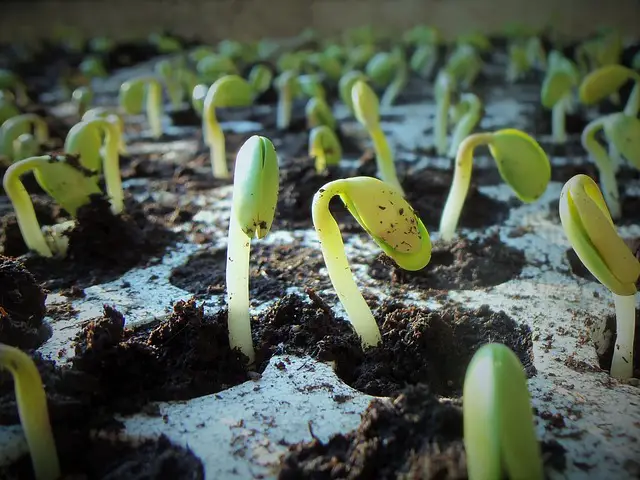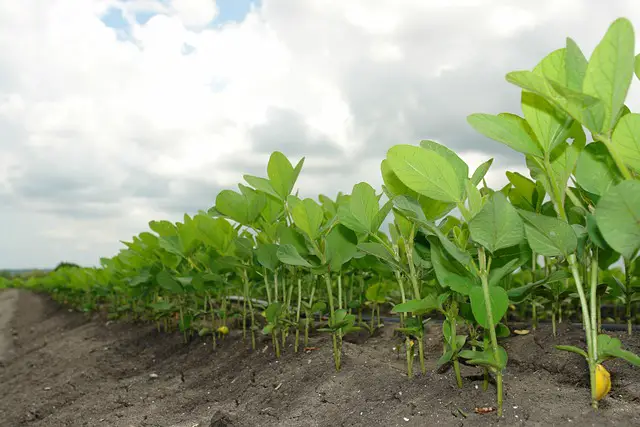Soybean farmers may be alarmed to find their crops turning yellow. Yellowing soybeans can indicate a range of issues, from nutrient deficiencies to diseases and pests. Identifying the cause of soybeans turning yellow is crucial to preventing yield loss and ensuring a healthy harvest.
Common causes of yellowing soybeans include nitrogen and potassium deficiencies, iron deficiency chlorosis, soybean cyst nematode, and fungal diseases. Testing and diagnosis are necessary to determine the exact cause of yellowing symptoms, as different issues require different management and treatment strategies.
Preventive measures such as crop rotation, soil testing, and seed treatments can also help mitigate the risk of yellowing soybeans.
Key Takeaways
- Yellowing soybeans can indicate a range of issues, from nutrient deficiencies to diseases and pests.
- Testing and diagnosis are necessary to determine the exact cause of yellowing symptoms, as different issues require different management and treatment strategies.
- Preventive measures such as crop rotation, soil testing, and seed treatments can help mitigate the risk of yellowing soybeans.
Check out these other popular posts:
- Why Are My Pilea Leaves Turning Yellow?
- Why Are My Oriental Lily Leaves Turning Yellow?
- Why Are My Orchid Stems Turning Yellow?
Identifying Yellowing Symptoms in Soybeans

When soybean leaves turn yellow, it is a sign that something is wrong. Identifying the cause of yellowing symptoms is crucial in determining the appropriate management strategy. In this section, we will discuss the different symptoms of yellowing in soybeans.
1. Leaf Yellowing
Yellowing of soybean leaves is often the first symptom of a problem. Chlorotic or yellowed leaves can be caused by various factors, including nutrient deficiencies, herbicide injury, soil pH imbalances, and diseases.
Nutrient deficiencies, especially iron and manganese, can cause interveinal chlorosis, where the veins remain green, but the tissue between the veins turns yellow.
2. Stunted Growth
Stunted growth is another symptom of yellowing in soybeans. When soybean plants do not grow as expected, it could be a sign of nutrient deficiencies or diseases. Stunted growth can also be caused by environmental factors such as temperature stress, drought, or flooding.
3. Brown Stem Rot
Brown stem rot is a fungal disease that can cause yellowing in soybean leaves. The disease affects the lower leaves first, causing them to turn yellow and then brown. As the disease progresses, the stems become brown and woody, and the leaves may fall off.
Brown stem rot is more common in fields with reduced tillage and continuous soybean cropping.
4. Sudden Death Syndrome
Sudden Death Syndrome (SDS) is a disease caused by a soil-borne fungus that affects soybean plants during the reproductive stage. The disease causes yellowing and necrosis of the leaves, starting from the lower leaves and moving up the plant.
The veins of the leaves remain green, while the tissue between the veins becomes yellow and eventually turns brown. SDS is more common in fields with high soil moisture and compacted soils.
Soybeans Turning Yellow – 5 Common Problems

Yellowing soybeans can be a sign of many different issues. Identifying the cause of yellowing can be crucial for the health and yield of your soybean crop. Here are some common causes of yellowing soybeans:
1. Soybean Cyst Nematode (SCN)
Soybean cyst nematode (SCN) is a microscopic worm that feeds on soybean roots and can cause significant damage to the crop. SCN can be a potential cause for soybeans turning yellow.
Conditions favoring SCN are continuous soybeans or soybeans grown in every other year rotation with added stress factors. It is estimated that SCN is present at some level in 85% of fields throughout the state of Illinois. Infected plants may become yellow and stunted.
2. Potassium Deficiency
Potassium deficiency is another common cause of yellowing soybeans. Lower leaves exhibit leaf margin yellowing or chlorosis. Potassium (K) deficiency symptoms are frequently seen on soybean at early development stages (starting as early as V3) but can also develop on plants throughout the growing season.
3. Dry Soil Conditions
Dry soil conditions can also cause soybeans to turn yellow. When soil is dry, the plant cannot uptake nutrients efficiently, which can lead to yellowing. In addition, dry soil conditions can also lead to poor root development, making it difficult for the plant to absorb nutrients.
4. Nitrogen Deficiency
Nitrogen deficiency is another potential cause of yellowing soybeans. Lower leaves usually become lighter green or chlorotic (yellowing) with upper leaves remaining darker green. Nitrogen deficiency can be caused by a lack of nitrate in the soil or by poor nodulation.
5. Iron Deficiency Chlorosis
Iron deficiency chlorosis is a yellowing of soybean leaves caused by a lack of iron in the soil. Iron is essential for the production of chlorophyll, which gives leaves their green color. Iron deficiency chlorosis is more common in high pH soils and can be exacerbated by wet soil conditions.
Testing and Diagnosis

When soybeans start to turn yellow, it is important to identify the cause quickly to prevent further damage to the crop. Testing and diagnosis can help farmers identify the underlying issue and take appropriate measures to address it.
1. Soil Testing
Soil testing is an essential step in diagnosing yellow soybeans. Farmers can collect soil samples from different areas of the field and send them to a lab for testing. The lab will analyze the samples and provide information on the soil’s nutrient levels, pH, and other factors that may be affecting soybean growth.
One important factor to consider is potassium levels. Soybeans require adequate potassium for healthy growth and development. Soil test K levels below 100 ppm are considered low and may lead to yellowing of soybean leaves. If potassium levels are low, farmers may need to apply potassium fertilizers to the soil.
2. Leaf Tissue Analysis
Leaf tissue analysis can also help diagnose yellow soybeans. Farmers can collect leaf samples from both healthy and yellowing plants and send them to a lab for analysis. The lab will test the samples for nutrient levels and compare them to established standards to identify any deficiencies.
Leaf tissue analysis can provide more accurate information about nutrient deficiencies than soil testing. It can help farmers identify which nutrients are lacking and take appropriate measures to address the issue.
3. Disease Diagnosis
Yellowing soybeans may also be a sign of disease. Farmers should inspect the plants for signs of disease, such as wilting, spots, or lesions. They can also send plant samples to a lab for disease diagnosis.
One potential cause of yellow soybeans is soybean cyst nematode (SCN). This pest can cause yellowing of soybean leaves and stunted growth. If SCN is identified, farmers may need to use resistant soybean varieties or manage the pest with nematicides.
Management and Treatment Strategies
1. Nutrient Management
Nutrient deficiency is a common cause of yellowing soybeans. To manage and treat this issue, farmers can conduct soil tests to determine which nutrients are lacking in their fields.
Once identified, they can apply the appropriate fertilizers to supplement the deficient nutrients. It is important to note that over-fertilization can lead to other issues such as nutrient runoff and environmental contamination.
2. Water Management

Water stress can also cause yellowing soybeans. Farmers can manage and treat this issue by ensuring adequate soil moisture levels through proper irrigation and drainage management. Additionally, planting soybeans in fields with good water-holding capacity can help prevent water stress.
3. Disease Management
Diseases such as sudden death syndrome (SDS) and brown stem rot (BSR) can cause yellowing soybeans. Farmers can manage and treat these diseases by practicing crop rotation, selecting resistant varieties, and applying fungicides.
Fungicides applied in-furrow or as seed treatments can be used at planting, while fungicides applied later in the season have little effect on SDS or BSR control as infection occurs in the roots.
4. Rotation and Variety Selection
Crop rotation and variety selection are important management strategies for preventing and treating yellowing soybeans. Rotating soybeans with other crops can help prevent the buildup of soil-borne diseases and pests.
Additionally, selecting soybean varieties with resistance to specific diseases can help prevent yellowing caused by those diseases.
Preventive Measures
Yellowing soybean plants can be prevented by taking certain measures. These measures include using seed treatments, planting resistant varieties, and managing soil moisture.
1. Seed Treatments

Using seed treatments can help prevent soybean plants from turning yellow. Seed treatments protect the seed from various diseases and pests, which can cause yellowing.
Some seed treatments also contain nutrients that can help the plant grow and develop properly. Farmers can choose from a variety of seed treatments, depending on the specific needs of their soybean fields.
2. Resistant Varieties
Planting resistant soybean varieties can also help prevent yellowing. Resistant varieties are less susceptible to diseases and pests, which can cause yellowing. Farmers can choose from a variety of resistant soybean varieties, depending on the specific needs of their soybean fields.
It is important to note that resistant varieties may not be effective against all diseases and pests.
3. Soil Moisture Management
Managing soil moisture is another important measure to prevent yellowing. Soybean plants require adequate moisture to grow and develop properly. Too much or too little moisture can cause yellowing.
Farmers can use various techniques to manage soil moisture, such as irrigation, drainage, and tillage. It is important to monitor soil moisture levels regularly and adjust management practices accordingly.
In addition to these measures, farmers should also ensure that their soybean fields have adequate nodulation. Nodules on soybean roots contain bacteria that fix nitrogen, which is essential for soybean growth and development.
Farmers should also choose soybean varieties that are appropriate for their maturity group and growing conditions.
Impact on Soybean Production
Yellowing soybeans can have a significant impact on soybean production. One of the main effects of yellowing is a reduction in yield. According to a study by the University of Missouri, soybeans with interveinal chlorosis, a type of yellowing, can experience yield losses of up to 40%.
Yellowing can also affect the growth of soybean plants. When soybeans are deficient in nutrients such as nitrogen, iron, or manganese, they can become stunted and have reduced biomass. This can lead to smaller plants and fewer pods, ultimately resulting in lower yields.
The environment can also play a role in soybean yellowing. Wet conditions can lead to iron deficiency chlorosis, a common cause of yellowing in soybeans. In addition, high temperatures can cause stress on soybean plants, which can result in yellowing and reduced yield.
Yellowing can also impact the flowering of soybean plants. Deficiencies in nutrients such as phosphorus and potassium can delay flowering, which can reduce the amount of time available for pod development. This can result in fewer pods and ultimately lower yields.
Weeds can also contribute to soybean yellowing. Weeds can compete with soybean plants for nutrients and water, which can result in nutrient deficiencies and yellowing. In addition, certain weed species can also host soybean cyst nematodes, which can cause yellowing and stunted growth in soybeans.
Finally, manganese toxicity can also cause yellowing in soybeans. High levels of manganese in the soil can lead to yellowing and necrosis of soybean leaves, which can reduce yield. This is particularly common in soils with a pH greater than 7.0.
Frequently Asked Questions

What are the common causes of yellowing in soybean plants?
Yellowing in soybean plants can be caused by a variety of factors, including nutrient deficiencies, disease, pests, and environmental stress.
Some of the most common causes of yellowing in soybean plants include nitrogen deficiency, potassium deficiency, iron deficiency, soybean cyst nematode, and sudden death syndrome.
What are the symptoms of nutrient deficiencies in soybeans?
Different nutrient deficiencies can cause different symptoms in soybean plants. For example, nitrogen deficiency can cause yellowing of the leaves, while potassium deficiency can cause yellowing of the leaf margins.
Iron deficiency can cause yellowing between the veins of the leaves, while phosphorus deficiency can cause stunted growth and purpling of the leaves.
How can I prevent my soybean plants from turning yellow?
Preventing yellowing in soybean plants requires proper management of nutrients, pests, and environmental stress. This includes maintaining proper soil pH, providing adequate irrigation, and using appropriate fertilizers.
Crop rotation can also help reduce the risk of soybean cyst nematode infestation.
What are some effective treatments for yellowing soybean plants?
The treatment for yellowing soybean plants depends on the underlying cause. For nutrient deficiencies, applying the appropriate fertilizer can often help.
For diseases and pests, appropriate chemical treatments may be necessary. It is important to identify the underlying cause of yellowing before attempting to treat it.
What are the most important nutrients for healthy soybean growth?
Soybean plants require a variety of nutrients for healthy growth, including nitrogen, phosphorus, potassium, calcium, magnesium, and sulfur.
Nitrogen is particularly important for vegetative growth, while phosphorus is important for root development and seed production. Potassium is important for stress tolerance and disease resistance.
How can I identify nutrient deficiencies in my soybean plants?
Identifying nutrient deficiencies in soybean plants requires careful observation of the plant’s growth and development.
Symptoms of nutrient deficiencies can include yellowing of the leaves, stunted growth, and abnormal leaf coloration. Soil testing can also help identify nutrient deficiencies in the soil.

Hey, I’m Lisa and I’ve been an avid gardener for over 30 years. I love writing, talking and living in the garden! Feel free to connect with me on my socials below


